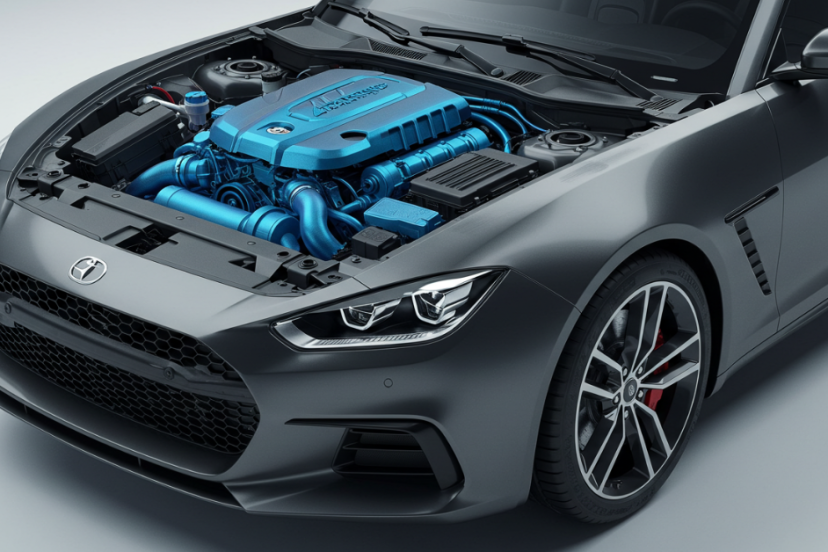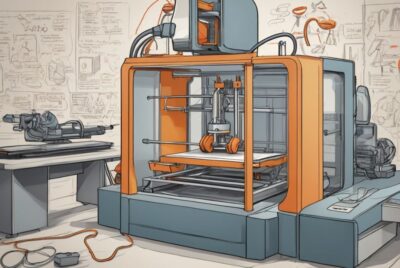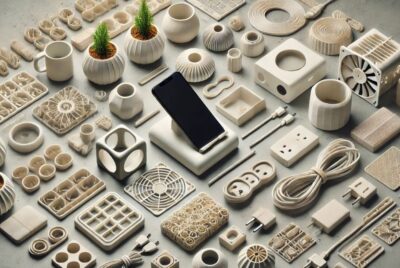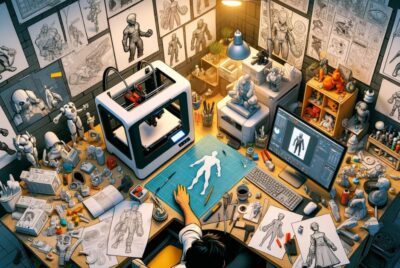How 3D Printed Car Parts Are Driving the Future of Sustainable Automotive Engineering
Have you ever marveled at the thought of a car part being printed and directly used in your vehicle? Welcome to the revolutionary world of 3D printed car parts, a game-changer in sustainable automotive engineering. This innovation is not just reshaping manufacturing processes but also steering us towards a more eco-friendly future. But how exactly is this happening, and why should we pay attention?
The Rise of 3D Printing
The ascendancy of 3D printing technology marks a pivotal shift in manufacturing paradigms, not just in the realm of hobbyists and enthusiasts but across global industries. Its roots trace back to the 1980s, with the advent of stereolithography (SLA), a technique enabling the creation of objects layer by layer using a UV laser to solidify photopolymer resin. Initially, the technology was prohibitively expensive and primarily used for rapid prototyping in aerospace and automotive industries.
However, the landscape began to change dramatically with the expiration of key patents in the early 21st century, ushering in a new era of innovation and accessibility. This democratization of 3D printing technology spurred a renaissance of sorts, characterized by an explosion of creativity, entrepreneurial spirit, and groundbreaking applications. The automotive sector, in particular, recognized the profound implications of 3D printing for design flexibility, cost reduction, and speed to market.
Today, the influence of 3D printing in automotive manufacturing is undeniable. Traditional constraints of tooling and setup costs that once made small production runs and customization financially unviable are now relics of the past. 3D printing allows manufacturers to iterate designs rapidly, test prototypes on the fly, and produce parts that are lighter, stronger, and more complex than ever before possible.
Moreover, the technology is not just revolutionizing how vehicles are designed and built but also embodying the principles of sustainable manufacturing. By reducing material waste and enabling the use of recycled materials, 3D printing is aligning automotive production with environmental sustainability goals.
From creating custom, one-off pieces for luxury vehicles to manufacturing critical components for electric cars, 3D printing is steering the automotive industry toward a more innovative, efficient, and eco-friendly future. As we stand on the cusp of this transformative era, one thing is clear: the rise of 3D printing is not merely an evolution in manufacturing technology—it is a revolution in how we conceive, design, and build the machines that power our lives.
Advantages of 3D Printing in Automotive Engineering
The advent of 3D printing technology has been a catalyst for innovation in automotive engineering, bringing with it a host of benefits that are reshaping the industry. These advantages span the entire production cycle, from conceptual design to the manufacturing floor, and even into the aftermarket parts sector.
- Unprecedented Design Flexibility: One of the most significant advantages of 3D printing lies in its ability to produce parts with complex geometries that are difficult, if not impossible, to create using traditional manufacturing methods. This freedom allows engineers to design and test innovative features without the constraints of conventional production techniques. It also opens up new possibilities for vehicle customization, enabling manufacturers to offer bespoke options to their customers with relative ease.
- Rapid Prototyping: The speed at which prototypes can be produced with 3D printing is unparalleled. What used to take weeks or even months can now be accomplished in a matter of days. This rapid prototyping capability accelerates the design process, allowing for quicker iterations and the ability to test and refine ideas more efficiently. It significantly shortens the time to market for new vehicles and components, providing a competitive edge in a fast-paced industry.
- Material Efficiency and Sustainability: Traditional manufacturing methods often involve subtractive processes that produce a considerable amount of waste. In contrast, 3D printing is inherently more material-efficient, as it adds material layer by layer to build a part. This not only reduces waste but also supports sustainability efforts within the industry. Moreover, with ongoing advancements in 3D printing materials, including recyclable and eco-friendly options, the environmental footprint of automotive manufacturing can be further minimized.
- Cost Reduction: While the initial investment in 3D printing technology can be significant, the overall cost savings in the long term are substantial. The ability to produce parts on demand eliminates the need for large inventories, reducing storage costs and minimizing waste from unsold parts. Additionally, the reduction in material waste and the efficiency of the production process itself can lead to significant savings, particularly for custom or low-volume parts.
- Supply Chain Simplification: 3D printing has the potential to dramatically simplify the automotive supply chain. Parts can be produced on-site or closer to the point of use, reducing the need for extensive logistics and transportation. This not only cuts costs but also reduces the lead time for parts delivery, improving the efficiency of repair and maintenance operations and enhancing customer satisfaction.
- Enhanced Performance and Innovation: The ability to create lighter and more optimized parts through 3D printing can lead to vehicles with improved performance, including better fuel efficiency and reduced emissions. The technology also encourages innovation, as engineers are no longer limited by traditional manufacturing constraints. This could lead to breakthroughs in vehicle design and functionality, further pushing the boundaries of what’s possible in automotive engineering.
How 3D Printing Works
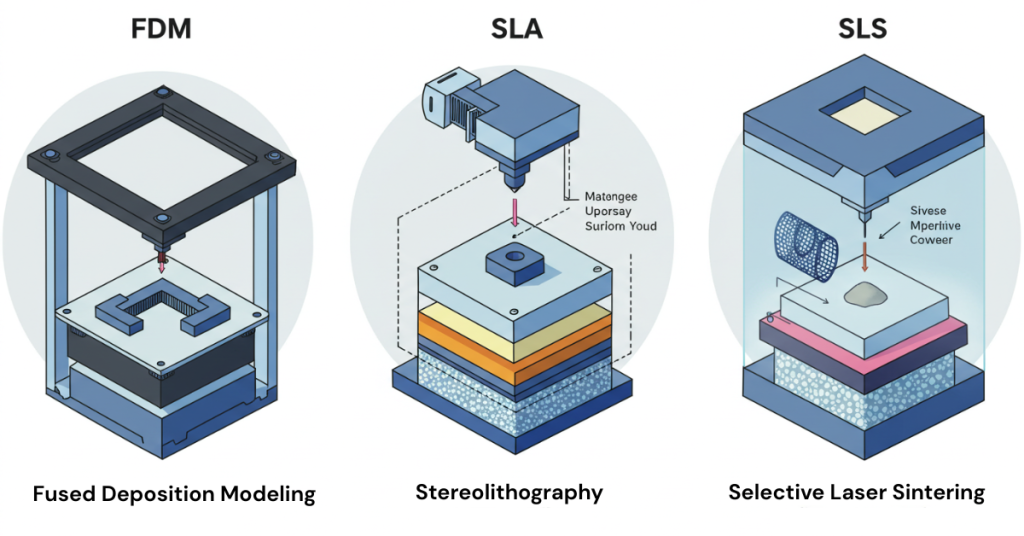
The magic of 3D printing, or additive manufacturing, lies in its ability to turn digital models into physical objects, layer by layer. This process transforms the way we think about manufacturing, especially in the automotive sector, where precision and customization are paramount. Here’s a simplified overview of how it unfolds:
- Designing the Digital Blueprint: Everything starts with a design. Using computer-aided design (CAD) software, engineers and designers create detailed 3D models of the car part they intend to manufacture. This digital blueprint is not just a static image but a fully realized model that includes the dimensions, properties, and functionality of the part.
- Preparing the Printer: Before printing can begin, the 3D printer needs to be prepared. This includes selecting the appropriate material (plastics, metals, composites, etc.) and setting up the printer with the correct specifications for the job. The choice of material depends on the part’s intended use, durability requirements, and desired properties.
- Slicing the Model: The 3D model is then ‘sliced’ by specialized software into hundreds or thousands of horizontal layers. This process converts the 3D design into a series of thin, 2D layers or cross-sections that the printer will build one atop the other. The slicing software also generates the path the printer head (or nozzle) will follow during the printing process.
- The Printing Process: With everything in place, the actual printing begins. The printer creates the part by depositing material, layer by layer, according to the sliced model’s instructions. There are several methods of 3D printing, but most automotive applications use one of the following:
o Fused Deposition Modeling (FDM): A thermoplastic filament is heated to its melting point and then extruded, layer by layer, to build the part.
o Stereolithography (SLA): A laser cures liquid resin into hardened plastic in a precise, layer-by-layer fashion.
o Selective Laser Sintering (SLS): A laser fuses small particles of polymer powder together, layer by layer.
- Post-Processing: After the printing is complete, the part often requires post-processing. This can include removing support structures, curing (further hardening the material, often under UV light), sanding, painting, or applying other finishes to meet the desired aesthetic and functional standards.
- Testing and Assembly: Finally, the printed part is tested to ensure it meets all specifications for its intended use. After passing quality control, it can be assembled into the vehicle or prepared for delivery as a replacement part.
Leading 3D Printers for Car Parts
The landscape of 3D printing technology is vast, with numerous players offering solutions tailored to different aspects of automotive manufacturing. From rapid prototyping to the production of end-use parts, here are some leading 3D printers that have proven to be invaluable in the automotive sector:
Stratasys Fortus 450mc:
This FDM (Fused Deposition Modeling) printer is renowned for its versatility and precision, making it ideal for creating durable car parts and prototypes. It supports a wide range of thermoplastics, allowing manufacturers to select materials based on the specific requirements of strength, thermal resistance, and rigidity.
EOS M 290:
Specializing in Direct Metal Laser Sintering (DMLS), the EOS M 290 is a powerhouse for producing high-quality metal parts. It’s particularly favored for components that require superior strength and durability, such as engine parts and custom fixtures. Its precision and ability to handle complex geometries make it a go-to for both prototyping and production.
HP Multi Jet Fusion 5200:
The HP Multi Jet Fusion technology is acclaimed for its speed and ability to produce parts with fine detail and optimal mechanical properties. This printer is suited for both prototyping and full-scale production, offering a robust solution for manufacturing intricate parts like gearboxes, custom interior components, or functional prototypes.
3D Systems ProX DMP 320:
Designed for metal 3D printing, the ProX DMP 320 excels in producing high-precision, geometrically complex automotive parts. It’s capable of working with a variety of metals, including aluminum and titanium, which are essential for lightweight and high-performance vehicle components.
Ultimaker S5:
While Ultimaker’s S5 model is more commonly associated with smaller scale or less intensive manufacturing tasks, its reliability, ease of use, and material versatility make it a fantastic option for automotive design studios and workshops. It’s particularly useful for creating detailed prototypes, jigs, fixtures, and tooling.
Markforged Metal X:
Markforged offers a unique ADAM (Atomic Diffusion Additive Manufacturing) technology, which is excellent for creating metal parts with intricate details. The Metal X is perfect for producing end-use car parts that require high strength and minimal weight, such as custom connectors and brackets.
While these high-end printers are ideal for industrial applications, there are also several more affordable options available for hobbyists, small businesses, or those just starting out with 3D printing car parts. Here’s a look at some entry-level 3D printers that offer a good balance between cost, ease of use, and capabilities:
Creality Ender 3 V2:
o Features: The Ender 3 V2 is popular among hobbyists due to its impressive print quality relative to its cost. It has a decent build volume for small to medium-sized parts and is highly upgradable, which allows for future enhancements.
o Suitable For: Ideal for beginners and intermediate users who are looking to experiment with printing various car accessories like custom knobs, fixtures, or even parts like brackets.
Anycubic Kobra 2 Neo:
o Features: Known for its auto-leveling feature and reliable extrusion of various filaments, the Kobra 2 Neo offers a streamlined user experience ideal for newcomers to 3D printing.
o Suitable For: Printing decorative car parts, small functional components, and prototyping.
Prusa Mini+:
o Features: Although slightly more expensive than other entry-level models, the Prusa Mini+ offers exceptional print quality and reliability. It’s compact but doesn’t compromise on the robustness of its prints.
o Suitable For: Those looking for a bit more advanced printer that offers finer detail, which can be great for intricate car parts like dashboard pieces or more complex fixtures.
Artillery Sidewinder X4:
o Features: Known for its high precision and large build volume, this updated model offers improved stability and faster printing speeds, making it a robust choice for larger projects.
o Suitable For: Larger car parts such as door handles, entire dashboards, or custom storage compartments.
Monoprice Voxel:
o Features: A user-friendly printer with a fully enclosed design, which helps in maintaining consistent temperature for better print quality. It also features a quick-change nozzle for easier maintenance and flexibility.
o Suitable For: Beginners and intermediate users looking to create small to medium-sized functional parts or decorative items.
These printers are excellent choices for someone starting out or looking to explore 3D printing for automotive applications without a significant initial investment. They offer a balance between affordability, ease of use, and sufficient capabilities to create a wide range of car parts and accessories. As your experience and needs grow, these printers can serve as a stepping stone to more sophisticated models or even commercial-grade machines.
Material Innovations
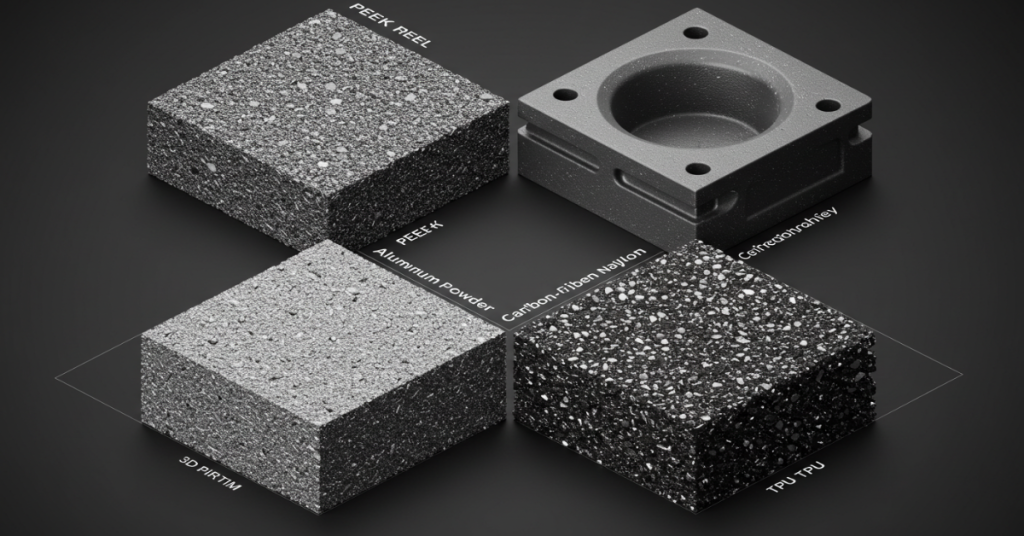
The evolution of 3D printing materials is as crucial as the technology itself, particularly in the automotive sector where material properties can significantly impact the performance, safety, and sustainability of vehicles. Recent innovations in materials are enabling manufacturers to overcome previous limitations and explore new frontiers in car design and production.
- Advanced Thermoplastics: High-performance thermoplastics such as PEEK (Polyether Ether Ketone) and PAEK (Polyaryletherketone) are gaining traction for their exceptional strength-to-weight ratios, resistance to high temperatures, and durability. These materials are ideal for producing parts that are exposed to harsh environments, such as engine components or parts within the transmission system.
- Metal Powders: The development of fine metal powders tailored for 3D printing processes like Direct Metal Laser Sintering (DMLS) and Binder Jetting has revolutionized the production of metal parts. Aluminum, titanium, and stainless steel powders are commonly used for their lightweight and high-strength characteristics, making them suitable for structural components, engine parts, and even custom exhaust systems.
- Composite Materials: Composite materials combine polymers with additives like carbon fiber, glass fiber, or Kevlar to enhance specific properties. These materials can offer improved strength, stiffness, and thermal stability while remaining lightweight. They’re particularly useful for components where weight reduction is critical without compromising structural integrity, such as in electric vehicle battery enclosures or aerodynamic elements.
- Biodegradable and Eco-Friendly Materials: As the automotive industry moves towards more sustainable practices, the development of biodegradable and eco-friendly 3D printing materials has become a focal point. These materials, derived from natural resources like cornstarch or recycled materials, are being explored for non-critical parts to minimize environmental impact.
- Elastomers: Flexible materials, or elastomers, such as TPU (Thermoplastic Polyurethane), are being increasingly used for parts that require flexibility or shock absorption. Applications include seals, gaskets, and hoses, where their ability to withstand vibration, impact, and wear is highly valued.
- High-Temperature Resins: For parts that must endure extreme heat, high-temperature resins have been developed to maintain their structural integrity and performance. These are crucial for components close to the engine or exhaust systems where temperatures can be particularly high.
- Conductive Materials: Innovations in conductive materials open up possibilities for integrating electrical circuits directly into printed parts. This can lead to the development of components with built-in sensors or electronic features, enhancing vehicle connectivity and functionality.
Case Studies
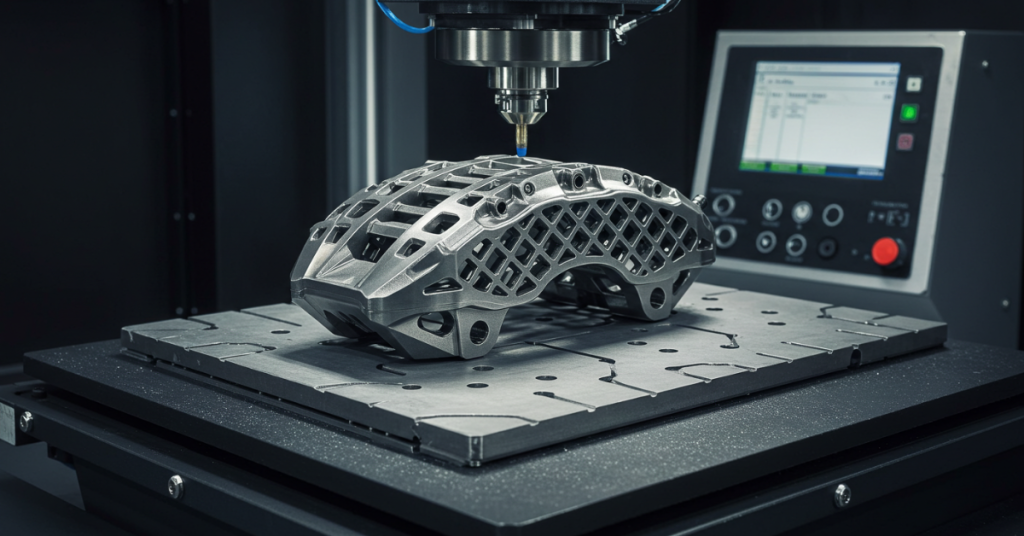
- Bugatti Chiron’s Brake Caliper: Bugatti took the automotive world by storm by developing the world’s first 3D printed titanium brake caliper for the Chiron. This piece not only boasts an intricate design that’s impossible to achieve through traditional manufacturing but also offers superior strength and performance. The use of titanium ensures the caliper is both lighter and more robust than conventional alternatives, contributing to the Chiron’s exceptional braking capabilities and overall performance.
- BMW’s i8 Roadster Metal Additive Manufacturing: BMW has been a pioneer in integrating 3D printing into its manufacturing processes. For the i8 Roadster, BMW utilized metal additive manufacturing to produce a lightweight yet sturdy roof bracket. This component, made from aluminum alloy powder, was crucial in reducing the vehicle’s weight without compromising on strength or safety, exemplifying how 3D printing can enhance vehicle design and performance.
- Ford’s Manufacturing Aids and Tooling: Ford Motor Company has embraced 3D printing not just for parts but also for creating manufacturing aids and tooling that significantly reduce production times and costs. One notable application is the use of printed tools to assist in the assembly of the Ford Mustang. These tools are tailored to specific tasks, improving efficiency and ergonomics for workers on the assembly line. Ford’s approach demonstrates how 3D printing can be applied beyond direct part production to impact the broader manufacturing ecosystem positively.
- Porsche’s Classic Car Parts: Porsche has turned to 3D printing as a solution for producing rare parts for its classic cars. Given the low demand and high cost of traditional manufacturing for such niche components, 3D printing offers an economical and practical alternative. Porsche now provides a service to produce rare parts on demand, ensuring that owners of classic models can maintain and enjoy their vehicles without the need for costly custom fabrication.
- Local Motors’ Strati – The 3D Printed Car: Local Motors made headlines with Strati, the first car to have its chassis and body fully 3D printed in a single piece. This innovative approach not only significantly reduced the number of parts and assembly time but also showcased the potential for 3D printing to revolutionize vehicle manufacturing. While Strati is more of a concept than a mass-market vehicle, it represents a bold step towards a future where cars might be printed on demand, tailored to individual specifications.
Environmental Impact
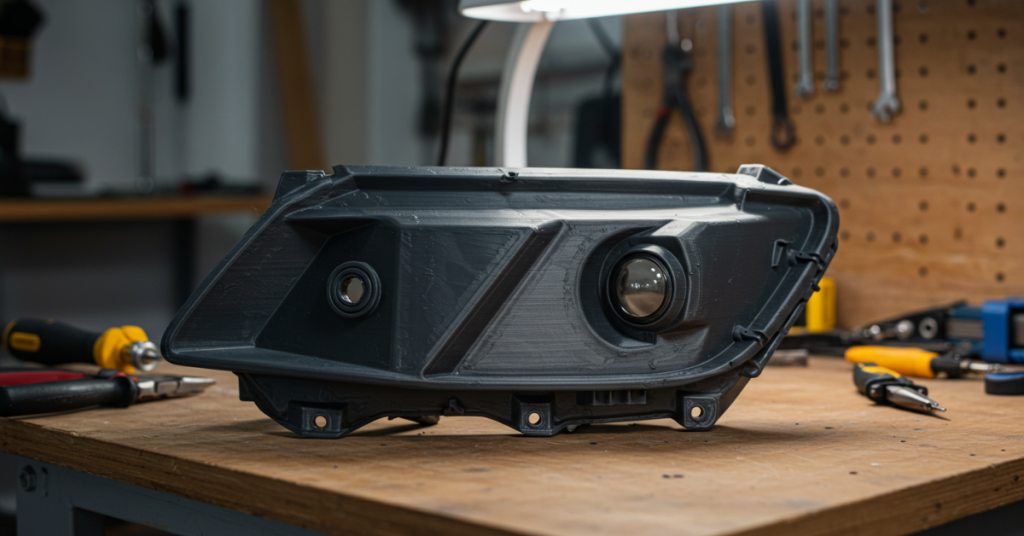
The integration of 3D printing into automotive manufacturing brings a promising avenue for enhancing environmental sustainability. This technology’s unique characteristics can contribute significantly to reducing the industry’s ecological footprint, from material usage to the lifecycle of the vehicle.
- Reduction in Material Waste: Traditional manufacturing methods, such as machining and casting, often involve subtractive processes that generate considerable waste. In contrast, 3D printing is an additive process, building parts layer by layer and using only the material necessary for the part itself. This efficiency drastically reduces the amount of waste produced, contributing to a more sustainable manufacturing cycle.
- Energy Consumption: The energy consumption of 3D printing varies widely depending on the technology and materials used. While some processes are energy-intensive, the overall energy footprint can be lower than traditional manufacturing methods, especially for complex or bespoke parts. Moreover, as 3D printing technology advances, improvements in energy efficiency are a key focus, further enhancing its environmental credentials.
- Use of Sustainable Materials: 3D printing opens up opportunities for using a broader range of materials, including recycled plastics and metals, as well as bio-based materials. The ability to print with these sustainable materials can significantly reduce the environmental impact of car parts production, supporting the automotive industry’s shift towards more eco-friendly practices.
- Supply Chain Optimization: By enabling local production and reducing the need for inventory and transportation, 3D printing can significantly streamline the automotive supply chain. This localized manufacturing approach minimizes the carbon emissions associated with transporting parts across long distances, contributing to a reduction in the overall carbon footprint of vehicle production.
- Lifecycle and Recyclability: The potential for creating lighter and more efficient parts through 3D printing can also lead to vehicles that are more fuel-efficient, further reducing their environmental impact during use. Additionally, the end-of-life aspect of 3D printed parts, particularly those made from recyclable or biodegradable materials, offers opportunities for improved recyclability and sustainability.
- Customization and Reduced Overproduction: 3D printing’s ability to produce parts on demand aligns with a more sustainable approach to manufacturing, where overproduction and excess inventory are minimized. This not only reduces waste but also ensures resources are used more efficiently, aligning production closely with actual demand.
Cost Analysis
The economic advantages of 3D printing in automotive manufacturing can be profound, although they vary based on the application, scale, and specific processes used. Here’s a closer look at the cost implications:
- Initial Investment and Setup Costs: One of the primary considerations is the initial investment in 3D printing equipment, which can be significant. However, this cost is often offset by the reduction in the need for expensive tooling and molds required for traditional manufacturing. Additionally, the setup costs for 3D printing are generally lower, especially for complex or low-volume parts, where traditional methods would necessitate costly custom tooling.
- Material Costs: While the cost of specialized 3D printing materials can be higher than conventional materials on a per-unit basis, the overall material efficiency of 3D printing (due to its additive nature) often results in lower material costs overall. The ability to use only the necessary material for each part significantly reduces waste, contributing to cost savings.
- Labor Costs: 3D printing can be highly automated, requiring less manual labor compared to traditional manufacturing processes. This automation can lead to substantial labor cost savings, especially for complex or labor-intensive parts. However, skilled operators and designers familiar with 3D printing technology are essential, which can influence labor costs differently.
- Manufacturing Speed and Efficiency: The speed of 3D printing can vary widely, but for prototyping and the production of complex or customized parts, it often leads to faster turnaround times compared to traditional methods. This efficiency can reduce overall production costs by speeding up the design and testing phases and bringing products to market more quickly.
- Inventory and Supply Chain Costs: 3D printing enables on-demand production, which drastically reduces the need for holding large inventories of parts. This not only lowers the costs associated with inventory management and storage but also reduces waste from unsold or obsolete inventory. Additionally, the potential for localized production can further reduce supply chain and transportation costs.
- Break-even Analysis: For many automotive applications, 3D printing becomes cost-effective at lower production volumes where the high setup costs of traditional manufacturing are not justifiable. However, as the volume increases, the unit cost advantage may shift towards traditional manufacturing. Conducting a break-even analysis helps determine the most cost-effective production method based on expected volumes.
Challenges & Solutions
The integration of 3D printing into automotive manufacturing isn’t without its challenges. However, for every problem, the industry is finding creative and effective solutions.
- Material Limitations:
o Challenge: Early 3D printing materials often lacked the durability or performance characteristics required for many automotive applications.
o Solution: Continuous research and development have led to a broad spectrum of new materials tailored for automotive use, including high-performance thermoplastics, metals, and composites that meet or exceed traditional material performance.
- Print Speed and Scalability
o Challenge: The speed of 3D printing processes can lag behind traditional manufacturing methods, posing scalability issues for mass production.
o Solution: Advances in printer technology are increasing print speeds, and the development of larger printers allows for multiple parts to be printed simultaneously. Additionally, integrating 3D printing into a hybrid manufacturing approach, where it complements traditional methods, can alleviate scalability concerns.
- Surface Finish and Precision:
o Challenge: Some 3D printed parts may require extensive post-processing to achieve the desired surface finish or dimensional accuracy.
o Solution: Improvements in printer resolution and the development of new printing techniques have enhanced surface finish and precision. Post-processing technologies and techniques are also becoming more efficient, further reducing the gap.
- Cost Efficiency:
o Challenge: The initial costs of 3D printing equipment and materials can be high, especially for high-quality metal printing.
o Solution: The cost of 3D printers and materials is gradually decreasing as the technology matures and becomes more widespread. Additionally, the overall cost savings from reduced waste, lower inventory needs, and minimized tooling expenses often offset higher initial costs.
- Technical Expertise:
o Challenge: There’s a steep learning curve associated with 3D printing, requiring specialized knowledge in design, material science, and printer operation.
o Solution: Educational institutions and companies are increasingly offering courses and training programs on 3D printing. Additionally, software advancements are making it easier to design parts specifically for 3D printing, lowering the barrier to entry.
- Regulatory and Standardization Issues:
o Challenge: The automotive industry is highly regulated, and there’s a lack of standardized guidelines specific to the production and testing of 3D printed parts.
o Solution: Industry bodies and regulatory agencies are working together to establish standards and certifications for 3D printed automotive parts. Collaborative efforts between manufacturers, material suppliers, and regulatory bodies are essential to navigate these regulatory challenges.
- Environmental Concerns:
o Challenge: While 3D printing reduces material waste, concerns remain about energy consumption and the recyclability of certain materials.
o Solution: Ongoing research into more energy-efficient 3D printing processes and the development of recyclable and bio-based printing materials are addressing these environmental concerns.
Future Trends
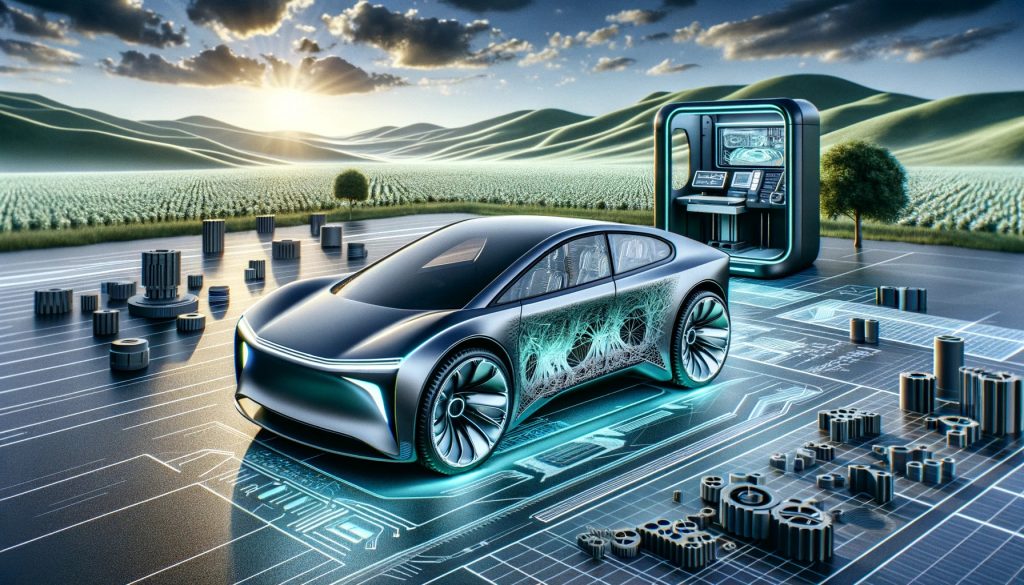
As we look ahead, several key trends are set to shape the future of 3D printing in automotive engineering, promising to further integrate this technology into the fabric of automotive design and manufacturing processes.
- Increased Material Diversity and Innovation: The development of new materials specifically designed for 3D printing will continue at an accelerated pace. Expect to see materials with enhanced properties, such as improved strength, flexibility, heat resistance, and sustainability. These innovations will expand the range of applications for 3D printed car parts, from structural components to more intricate and functionally critical systems.
- Integration of Electronics and Smart Features: The future will likely witness the growth of 3D printing techniques capable of integrating electronic circuitry directly into printed parts. This advancement could lead to parts with embedded sensors, connectivity features, and other electronic functionalities, opening up new avenues for smart vehicles and Internet of Things (IoT) integration within automotive design.
- Advancements in Printing Speed and Scale: As 3D printing technologies evolve, significant improvements in printing speed and the ability to print larger components are expected. These advancements will address current scalability challenges, making 3D printing more viable for mass production and not just limited to prototyping or niche applications.
- Customization at Scale: The demand for personalized and custom-designed vehicles is on the rise. 3D printing uniquely positions automotive manufacturers to meet this demand efficiently, offering the possibility of customized vehicle components at scale without significantly impacting production time or costs.
- Sustainability and Circular Economy: The automotive industry’s focus on sustainability will drive further adoption of 3D printing, leveraging its material efficiency and the potential for using recycled materials. Additionally, the concept of a circular economy, where parts are designed for reuse, recycling, or biodegradability, will become increasingly integrated into 3D printing practices.
- Hybrid Manufacturing Processes: Combining traditional manufacturing methods with 3D printing (hybrid manufacturing) will become more commonplace. This approach allows manufacturers to leverage the strengths of each method, optimizing production workflows for efficiency, cost-effectiveness, and performance.
- Regulatory Evolution and Standardization: As 3D printing becomes more entrenched in automotive manufacturing, regulatory frameworks and standards will evolve to better accommodate and govern the use of this technology. This will ensure that 3D printed car parts meet strict safety and performance criteria, fostering greater acceptance and integration of 3D printed components in the industry.
How to Get Started
Embarking on the journey of 3D printing within the automotive industry requires a strategic approach, from understanding the technology to implementing it effectively. Here are essential steps to get started:
- Educate Your Team:
Begin with a solid foundation of knowledge. Invest in training for your team to understand the basics of 3D printing, including the different technologies, materials, and applications relevant to automotive manufacturing. This knowledge is crucial for making informed decisions and fostering innovative thinking.
- Assess Your Needs:
Identify the specific areas where 3D printing can add value to your operations. This could involve prototyping, tooling, manufacturing of final parts, or even customization services for customers. Understanding your needs will help tailor your approach to 3D printing technology.
- Select the Right Technology and Materials:
With a variety of 3D printing technologies and materials available, selecting the right ones for your automotive applications is critical. Consider factors such as material properties (strength, flexibility, heat resistance), part complexity, finish requirements, and production volume.
- Invest in Equipment:
Based on your needs and the selected technologies, invest in the appropriate 3D printing equipment. Start with a printer that matches your current requirements but keep scalability in mind. It’s also wise to consider partnering with 3D printing service providers for access to a broader range of technologies and materials without the upfront investment.
- Prototype and Test:
Use 3D printing for rapid prototyping to accelerate the design and testing phases of new automotive parts. This not only speeds up the development process but also allows for iterative testing and refinement, ensuring the final product meets all specifications and standards.
- Develop In-House Expertise
While starting with external partners can be beneficial, developing in-house 3D printing expertise is valuable for long-term success. This includes building a team skilled in design for additive manufacturing (DfAM), operating 3D printers, and post-processing techniques.
- Implement a Pilot Project:
Before fully integrating 3D printing into your production line, implement a pilot project. Choose a project that represents a real challenge your company faces, whether it’s a specific part, tool, or prototype. This project will provide valuable insights into the practicalities of incorporating 3D printing into your workflow and help refine your process.
- Evaluate and Scale:
After completing the pilot project, evaluate the outcomes against your objectives. Assess the efficiency, cost-effectiveness, and quality improvements provided by 3D printing. Use these insights to scale your 3D printing operations, integrating the technology more deeply into your manufacturing processes where it adds the most value.
- Stay Updated and Innovate:
The field of 3D printing is rapidly evolving. Stay informed about the latest developments in 3D printing technologies, materials, and applications. Continuous learning and innovation will keep your automotive manufacturing processes at the cutting edge.
Conclusion
As we’ve journeyed through the realms of 3D printing technology and its profound implications for automotive manufacturing, one thing becomes crystal clear: the fusion of innovation, sustainability, and efficiency embodied in 3D printed car parts is not just a glimpse into the future—it’s a roadmap for the next revolution in automotive engineering.
The adoption of 3D printing in the automotive sector is transforming traditional manufacturing paradigms, offering unprecedented flexibility in design, significant reductions in waste, and a path towards more personalized and sustainable vehicle production. From the intricacies of material innovations to the compelling narratives of real-world case studies, the message is unmistakable—3D printing is steering the automotive industry towards a future where every component can be optimized for performance, environmental impact, and cost-efficiency.
Yet, as with any journey of transformation, challenges lie ahead. Material limitations, scalability, cost considerations, and the need for specialized expertise are hurdles that the industry continues to navigate. However, the solutions emerging—through technological advances, collaborative efforts, and a relentless pursuit of innovation—underscore a collective commitment to overcoming these obstacles.
Looking forward, the trends in 3D printing promise an era of automotive manufacturing where customization and sustainability go hand in hand, where the lifecycle of every part is optimized for minimal environmental impact, and where the barriers between imagination and reality in vehicle design become increasingly blurred.
For manufacturers, embracing 3D printing offers a competitive edge in a rapidly evolving industry. For consumers, it heralds a future where the cars we drive are more aligned with our values and aspirations for a sustainable planet. And for the automotive industry at large, the journey into 3D printing represents a pivotal shift towards a more innovative, efficient, and environmentally responsible future.
As we stand on the brink of this exciting new era, the potential of 3D printed car parts in driving forward sustainable automotive engineering is not just promising—it’s palpable. The road ahead is paved with opportunities for transformation, and it’s clear that 3D printing will play a crucial role in shaping the vehicles of tomorrow.
In conclusion, the fusion of 3D printing with automotive manufacturing is more than a technological marvel; it’s a beacon for sustainable innovation, heralding a future where the cars we drive are as conscious of the environment as we strive to be. As we accelerate towards this future, the role of 3D printed car parts in driving sustainable automotive engineering is not just significant—it’s indispensable.
FAQs
- What makes 3D printed car parts sustainable?
3D printed car parts contribute to sustainability in several ways. First, the additive manufacturing process significantly reduces material waste by using only the necessary material to create a part. Second, it allows for the use of recycled materials and the development of biodegradable alternatives. Additionally, the ability to produce parts on-demand reduces the need for large inventories and the associated energy consumption, further minimizing the environmental footprint of manufacturing processes. - Can any car part be 3D printed?
While 3D printing technology has advanced significantly, not every car part is currently suitable for 3D printing due to material, strength, or size constraints. However, a wide range of parts, including complex components, custom fittings, and prototypes, can be effectively produced using 3D printing. Ongoing advancements in materials and printing technologies are continually expanding the possibilities. - What are the main challenges in 3D printing car parts?
The main challenges include material limitations, ensuring the durability and longevity of printed parts, the cost of 3D printing for mass production, and the need for specialized design and printing expertise. Addressing these challenges requires ongoing research, development, and investment in new technologies and materials. - How does 3D printing change the automotive design process?
3D printing allows for greater flexibility and innovation in automotive design by enabling the creation of complex geometries that are difficult or impossible to achieve with traditional manufacturing methods. It also significantly speeds up the prototyping process, allowing designers to test and refine their ideas quickly and cost-effectively. - What are the future developments expected in 3D printing for automotive?
Future developments include the creation of stronger and more diverse materials, improvements in printing speed and volume for mass production, the integration of electronics and smart features directly into printed parts, and further advancements in sustainability, such as the use of eco-friendly materials and recycling of 3D printed parts.

